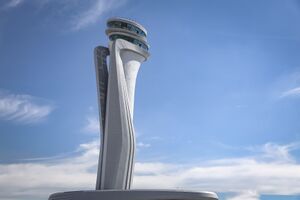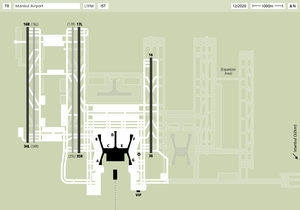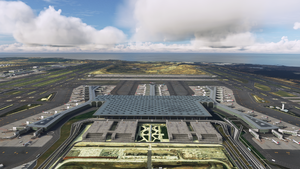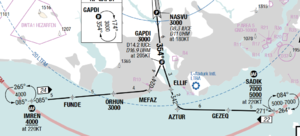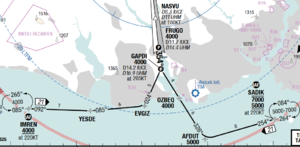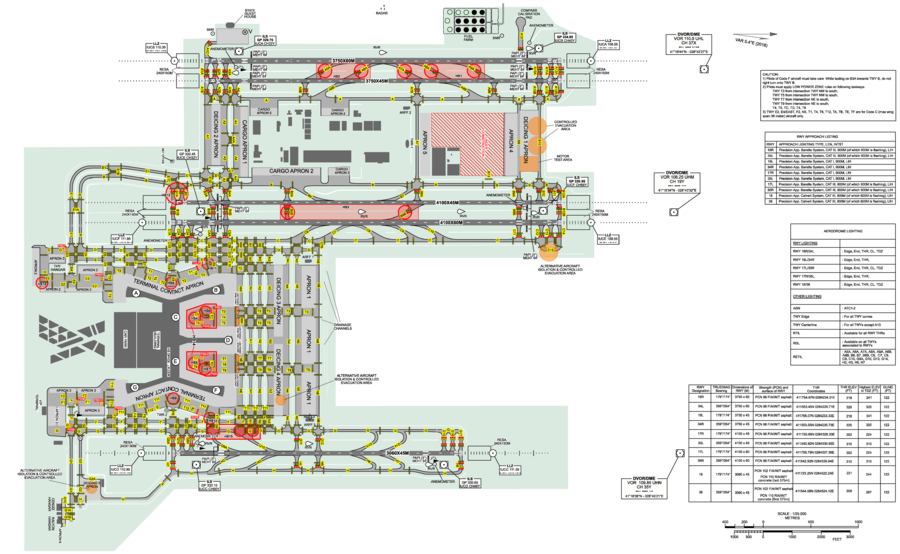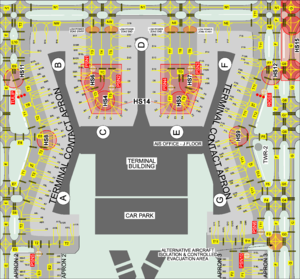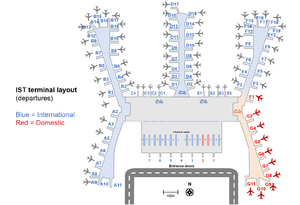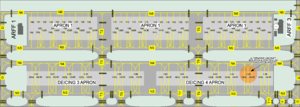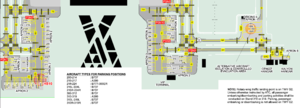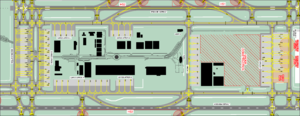Istanbul Airport
Istanbul Airport (IATA: IST, ICAO: LTFM) is the biggest airport in Turkiye. Located in north west of Istanbul, the airport is the busiest and biggest airport in Europe as per 2022 statistics of EuroControl[1]. The airport has 5 runways, fuel farm, dedicated cargo area consisting of 5 apron (29 heavy stands), several warehouses and facilities (biggest one being Turkish Cargo followed by DHL and UPS), and is home to world's biggest airport terminal (under one roof).
The airport has not been completed. As of January 2023, only Phase 1a and 1b is finished. The final phase of the airport includes 8 runways, 2 terminals with 1 satellite terminal.
Sceneries
Payware
There are multiple payware options depending on the simulator for Istanbul Airport. You can find more information from the table below.
| Simulator | Developer | Publisher | Links |
|---|---|---|---|
| P3D v4/v5 | SceneryTR | SceneryTR | https://secure.simmarket.com/scenerytr-stanbul-airport-ltfm.phtml |
| X-Plane | SceneryTR | Aerosoft | https://secure.simmarket.com/aerosoft-airport-istanbul-x-plane-11.phtml |
| MSFS 2020 | SceneryTR | SceneryTR | Can be bought from MarketPlace
OR https://secure.simmarket.com/scenerytr-istanbul-airport-ltfm_msfs.phtml |
Freeware
There are also freeware options available for Istanbul Airport. However there is significant difference in quality.
| Simulator | Developer | Publisher | Links |
|---|---|---|---|
| FSX/P3D | Hakan Daghan, Kamil Uzun, Erman Gokman Pilicoglu, Muhtesem Firtina Ozcinar | Turkish Virtual | https://turkishvirtual.com/turkishvirtual_LTFM_scenerys.asp |
| X-Plane | Mali Oguducu, Hayri Buberci, Kamil Uzun, Muhtesem Firtina Ozcinar | Turkish Virtual | https://turkishvirtual.com/turkishvirtual_LTFM_scenerys.asp |
| MSFS 2020 | Hayri Buberci, Mali Oguducu, Kamil UZUN, M Firtina Ozcinar | Turkish Virtual | https://turkishvirtual.com/turkishvirtual_LTFM_scenerys.asp |
Arrival Procedures
Istanbul Airport is located within Yesilkoy TMA (Terminal Manoeuvring Area). Yesilkoy TMA covers Istanbul Airport (LTFM), Sabiha Gokcen Airport (LTFJ), Ataturk Airport (LTBA), Samandira Airbase (LTBX), Corlu Ataturk Airport (LTBU), Hezarfen Municipal Airport (LTBW), Cengiz Topel Airport (LTBQ), Canakkale Airport (LTBH), Bursa Yunuseli Airport (LTBE) and Bursa Yenisehir Airport (LTBQ).
Istanbul Airport utilizes RNAV in all of its procedures. In addition, P-RNAV (Precision-Area Navigation, RNP1) capability is required. If unable, pilot must inform the controller so that aircraft can be given radar vectors to final. Arrival into Istanbul Airport might seem complicated to some pilots however it is actually very simple. LTFM STARs utilize PMS (Point Merge System) for efficient airspace control, separation, and to control traffic flow within Yesilkoy TMA. All STARs utilize idle descent philosophy until PMS entry. These point merge systems act as an arc of a circle and ease air traffic control.
STARs
The STARs at Istanbul airport are designed to be ambiguous between the active runways. For instance, if northern config is active, RILEX2A STAR will end at IMREN waypoint, and IMREN is IAF (Initial Approach Fix) for all approach procedures for all northern runways. This means, whether you land at 34L, 35R or 36 (when north config is active), you still use the same STAR procedure for all runways. You can find the STAR designator table on the next page.
| Active Runway Configuration | ||||||
|---|---|---|---|---|---|---|
North Configuration uses the following STAR identifiers.
| ||||||
South Configuration uses the following STAR identifiers.
|
As Istanbul Airport utilizes multiple configurations depending on traffic, weather, congestion, NOTAMs etc. You might be cleared to a different STAR compared to another traffic that is flying exactly the same route as you. Default designators for northern config (34/35/36) is 2A and default designator for southern configuration (16/17/18) is 2B. These STARs keep the traffic arriving west to use the west PMS and traffic arriving from east to use the east PMS. 2N and 2P STARs are designed to ease the workload of a PMS, by making the traffic to use the opposite PMS (traffic arriving from west to use the east PMS or to enter PMS from north instead of south at different altitude e.g).
North Config
South Config
Transitions and Approach Phase
As mentioned previously, Istanbul Airport utilizes Point-Merge System. Each PMS leads to last point of the STAR and the entry point of the approach transition . For northern config, IAF for west PMS is IMREN, for east config it is SADIK. For south config, IAF for west PMS is INSTA and for east PMS it is DIVDI. Flying the correct transition is crucial and must. Each pilot is responsible for selecting the correct transition. This transition is NOT a STAR transition but transition for the approach procedure. There are different approach procedures and each has different transition phase (both laterally and vertically), go around procedure and used differently to streamline the independent parallel approach procedure . As a pilot, you must make sure you have programmed your FMS using the correct approach procedure and transition. If ATC clears the traffic for ILS-X 35R via IMREN transition, it is pilot's responsibility to fly ILS-X approach via IMREN transition. Since transitions are a must as they play a crucial role in the independent parallel approach procedure, pilot's must fly the transition both laterally and vertically at all times. If the transition is not selected correctly in the aircraft's FMS, the plane will fly directly to FAF, skipping the transition completely. This is not allowed for approach procedure into Istanbul as each approach procedure and transition is very different than one another, both laterally and vertically. You can see an example of how ILS-X and ILS-Z transition differs from the pictures below (you can see they are both laterally and vertically different).
Ground Layout
Istanbul airport is on the list of biggest airports as per surface area, with staggering 76.5 million m2 of land area. The airport has 5 runways, 34L/16R, 34R/16L, 35L/17R, 35R/17L and 36/18. Between RWYs 34 and 35, the main MRO and cargo area can be found. Between RWY 35 and 36, main passenger terminal and the stands can be found. Most gates and stands utilize MARS (Multiple Aircraft Ramp System). This increases the efficiency and gate usage significantly. With the MARS system, one gate can be shared by either 2 small to medium aircraft or 1 heavy (widebody) aircraft. In Istanbul Airport, MARS system uses L (as left) and R (as right) abbreviations for medium/split gates. For instance B4 gate is used by either 1 heavy aircraft or 2 medium aircrafts use B4L (Gate B 4 Left) and B4R (Gate B 4 Right).
Aprons and Terminal
Main Passenger Terminal and Terminal Contact Apron
Passenger terminal at Istanbul Airport both house international and domestic traffic. The gates are split into piers and identifiers.
| Gates/Pier | International | Domestic |
|---|---|---|
| A Gates | X | |
| B Gates | X | |
| C Gates | X | |
| D Gates | X | |
| E Gates | X | |
| F Gates | X* | F1 |
| G Gates | X |
C and E gates are only medium gates and are connected directly to the main building. A, B, C, D, F and G gates are located in their respective piers.
A Pier
A gates/pier is only for international flights. Gate A9 is the only gate that does not have MARS system. Gate A2 is only the one of the 2 gates that is equipped with third jetbridge, which is used for A380 flights.
B Pier
B gates/pier is used located in international area of the terminal and only international flights use these gates. Gates B1, B3, B5, B6, B7, B8, B9, B10, B12 and B18 utilize MARS system. Gates B4, B13, B14, B15, B16, B17 are heavy gates. Gate B2 is only to be used by small to medium aircraft.
C Gates
C gates are located in the West Cul-de-Sac of the terminal complex and have only 4 gates. All gates (C1, C2, C3, C4) are to medium gates.
D Pier
D Pier is used heavily by long range flights due to being the most heavy gates. Out of 19 gates, only gates D1, D2, D3, D4 are medium gates. Rest of them are heavy only.
E Gates
Just like C gates, E gates have only gates (E1, E2, E3, E4). They are located in the East Cul-de-Sac.
F Pier
F pier has mix of gates and flights. Gate F2 is medium only whereas gates F3, F4, F5, F6, F7, F8, F9, F12, F13 use MARS. Gates F14, F15, F16, F17, F18, F19 are heavy only gates. F1 gate uses MARS however is domestic only.
G Pier
G pier is to be used only for domestic flights. Entire G pier utilizes MARS.
Apron 1
Apron 1 is located north of Terminal Area, situated between taxiways D and G. It contains 33 medium stands (100-132 and 149) and 16 MARS stands (133-148).
Apron 2 and 3
Apron 2 is situated south of A pier and Apron 3 is located south of G pier. Both aprons contain MARS and narrowbody-only stands. 2xx stands represent stands located in apron 2 and 3xx stands in apron 3. Stands 218, 219, 225 and 226 are used by Turkish Technic and should not be used. Stands 316, 317, 318, 319 is used only for VIP.
For Apron 2:
- 200 - 214 -> Medium gates
- 220 - 224 -> MARS
For Apron 3:
- 300 - 312 -> Medium gates
- 313 - 315 -> MARS
Cargo and MRO Aprons
Located between runways 34R/16L and 35L/17R, there are 5 cargo aprons and 2 MRO aprons. Cargo stands start with K. Stands K1, K2, K3, K4, K5, K6, K7, K8, K9 all utilize MARS wheres the remaining stands K10-K21 (used ONLY by Turkish Cargo) and K50-K57 are heavy gates. 4xx and 5xx stands are used only by Turkish Technic.
Taxi Procedures
Istanbul Airport is very big and might seem scary regarding all the taxiways and size however the pre-defined taxi procedures make it very easy for both pilots and ATC. This section outlines these procedures, taxi limits, speed limits and terminal area.
Terminal Area
Main terminal has predefined exits and routes. These predefined routes and directions help ease the traffic flow and ground movement on the a
